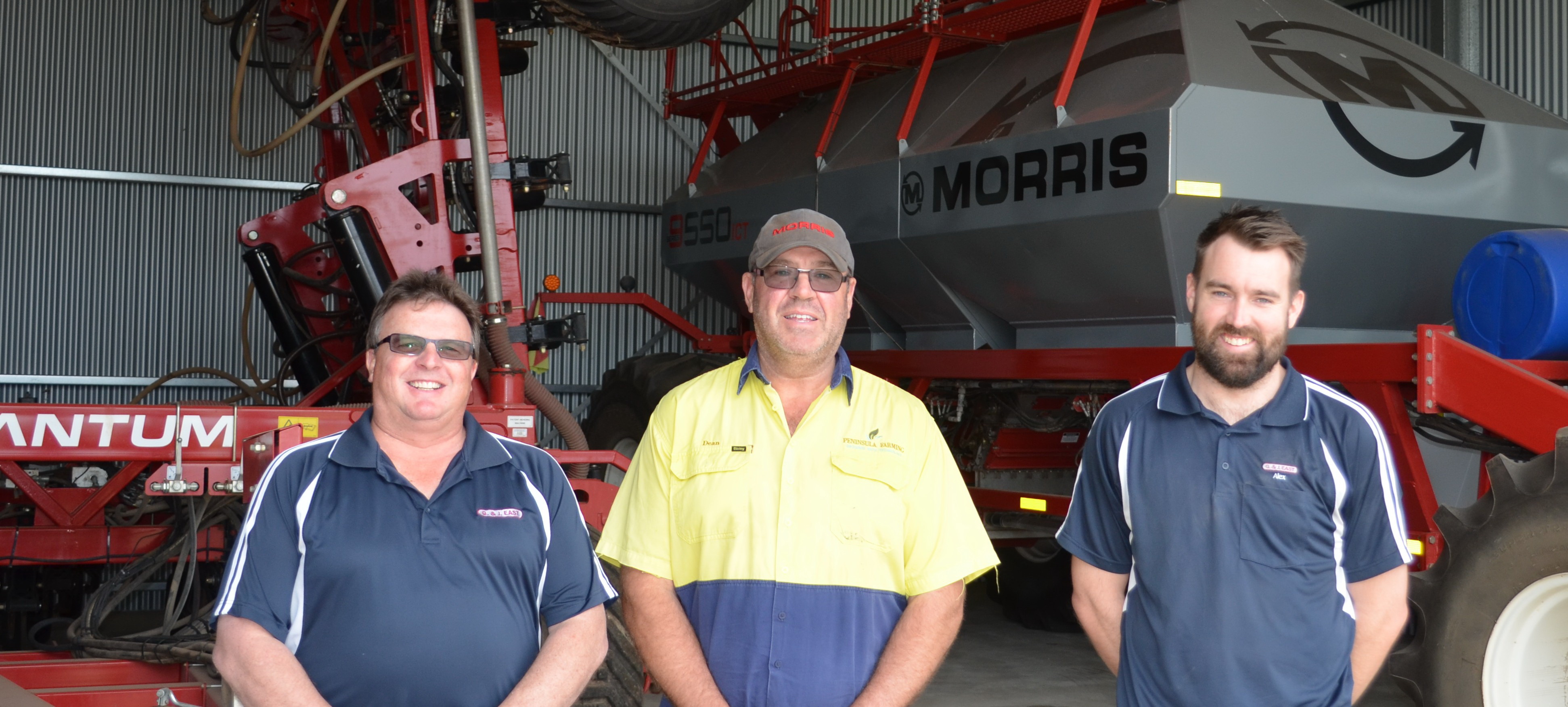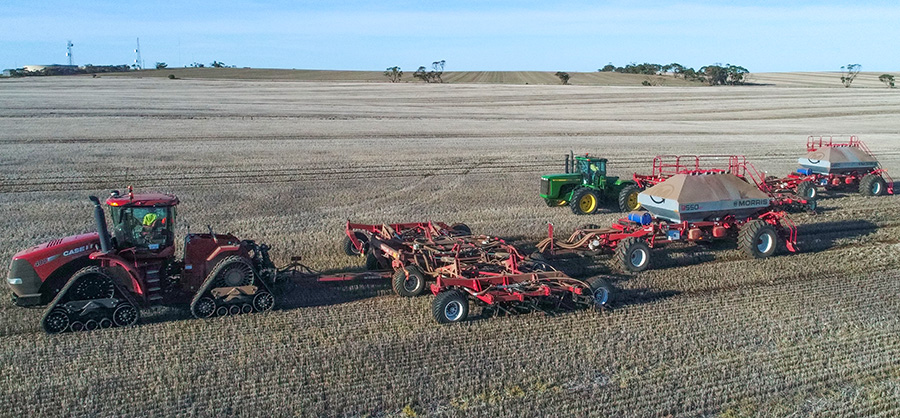

18 September 2020
For a major cropping expansion on South Australia’s Yorke Peninsula, Farm Manager Dean Bruce helped guide significant investment into new seeding rigs. They already had narrowed their focus to two suitable systems to choose from. Dean then went through things with a fine tooth and put together a list of pros and cons for each system, helping decide which one was the clear winner…
AT A GLANCE
 Dean Bruce (centre), Farm Manager at ‘Peninsula Farming’ on SA’s Yorke Peninsula, with Kris McCracken and Alex East, both of G & J East at Kadina, and one of the farm’s Morris seeding systems, including a Quantum air drill and 9550 tow-behind air cart fitted with the manufacturer’s Input Control Technology (ICT) for section control.
Dean Bruce (centre), Farm Manager at ‘Peninsula Farming’ on SA’s Yorke Peninsula, with Kris McCracken and Alex East, both of G & J East at Kadina, and one of the farm’s Morris seeding systems, including a Quantum air drill and 9550 tow-behind air cart fitted with the manufacturer’s Input Control Technology (ICT) for section control.

The two Morris 12-metre (40-foot) Quantum air drills and 19,500-litre, triple bin 9550 air carts at work. The Morris air drills particularly suited the farm’s 3-metre controlled traffic system.
When you double your cropping program and, as a result, plan a major seeding system upgrade from a 25-year-old machine to two complete new rigs, you are going to be looking long and hard at such a serious investment for the foreseeable future.
This was the scenario that played out for ‘Peninsula Farming’ on South Australia’s Yorke Peninsula leading into the 2019 season.
Farm Manager Dean Bruce said the full-time cropping enterprise increased its capacity to enable expansion, more than doubling its program to 4800 hectares all within an 80-kilometre radius of its main Maitland farm.
Wheat, barley, lentils and faba beans are grown over a wide range of soils, including sand over loam and non-wetting sands through to underlying limestone ridges with loamy tops and calcareous soils running into heavy clays.
Rainfall also varies from 250-300 millimetres near the coast up to 500-600mm in central areas, contributing to crop yields ranging from 3 to 8 tonnes/ha for cereals and 1 to 4t/ha for pulses.
Dean said the seeding system investment was coming down to air hoe drills or Morris Quantum air drills, also with the manufacturer’s 9550 tow-behind carts fitted with Input Control Technology (ICT) for section control, and the latter was the strong winner.
He said the 12-metre (40-foot) Quantum air drills particularly suited their 3m controlled traffic farming system.
“For broadacre agriculture, it is one of the first sowing bars released on a true 3m centre for controlled traffic farming,’’ said Dean, who has been managing the farms for six years after earlier operating an agricultural contracting business on the peninsula.
“Every third run we lift tynes and lock them up on the 3m centre, so they don’t sow and we effectively leave the paddock ‘highway’ every 36m, which was a great benefit with the Quantums.’’
Tyne spacings have been reduced from 300mm with the old Flexi-Coil bar and air cart to 250mm with the Quantums and they interow sow every alternate year, allowing a trellis for pulses as well as good moisture retention and nutrient distribution.
Trimble GPS guidance linked with a Protrakker hydraulic hitch ensures the most accurate implement steer, while the Topcon X35 controllers with the Morris carts manage the seeding inputs.
Dean said when he was investigating the seeding bars he pencilled columns with pros and cons and while the Morris Quantum had so many pros and not many negatives, the air hoe drills had quite a few negatives.
“The Quantum just outweighed it by so much,’’ he said.
“All the changes that Morris made from the C2 drills were exactly what we wanted.
“It is a bigger, stronger, awesome toolbar that does not get bullied around when harder areas are sown into in paddocks. The framework is very strong and it is really well finished-off. This also made it easy to set up the Protrakker and install the GPS. It’s very easy to steer straight.
“The larger flotation tyres are amazing and you don’t get compaction. When you look at them, you just go: ‘Wow’. For our varied soil types and where you can get problems with emergence in sowing tracks, this is important. In heavier soil types, there is no problem with germination.
“They (Morris) have also addressed the trash flow from the C2 parallelogram that had some issues. We were worried about it, but it is excellent with the Quantum.
“The sowing depth on each individual tyne is unbelievable. Each tyne works individually with the press wheel attached to it and you can monitor the pressure on the press wheel with the controller in the cab.
“Sowing depth is crucial, certainly in some of our sandy rises. Each tyne follows the contour of the ground, so you can really get good sowing depth. We saw it last year with our emergence. We weren’t allowing for the precision of the bar and so the first third of our program was sown a bit deep before we got it right. It took a while to adjust, but we got reasonable depth with two-thirds of the program and really good emergence.
“With previous bars, you would sow deeper in the flats and shallower on the rises, but with the parallelogram, once you set it, it stays there, which is a huge thing with our variable paddocks.’’
Using 2.5-centimetre (1-inch) Atom Jet points and a single shoot system, seed is placed at a shallow depth of 25-30mm.
“With our current sowing technique, controlling the seed placement over our various soil types is the key,’’ Dean said.
“Even germination is worth a lot, not only for moisture utilisation but also in relation to chemical damage as well. You’ve got to have chemical and seed in the right spot.’’
The two Quantum air drills had new openers fitted as part of a national upgrade by Morris and Australian distributor, McIntosh Distribution.
“Even though we had no problems with the old openers, the whole new cast assembly with the latest system is fantastic,’’ Dean said.
He said Morris and McIntosh Distribution, also through local dealer, G & J East at Kadina, deserved credit for such an upgrade program and the work and investment involved.
“It gives us great confidence in our decision for the product. Morris has been really good.’’
“The Morris systems are now generating a lot of interest on the peninsula.’’
Dean said the transport width of the Quantums was another great feature.
“We have 13 different farms in an 80km radius, so we are on the road a lot and the narrow width is absolutely brilliant. We can fold it up and get down the road quick – it’s a huge tick.’’
He said together with the Morris 19,500-litre, triple bin air carts with section control, the system was very precise.
“We have 48 sowing tynes over six sections, so eight sowing tynes per head and the metering rollers for each head just disengage when required.’’
“We’ve virtually got no over-sow because we have got 2m sections.
“We have seen N fertiliser savings in funny-shaped paddocks. The input savings would have to be around 10 per cent or a bit more. It replicates what we do with the sprayers, where we have eight sections.
“Apart from the section control savings, it also helps with other problems like disease and lodging that starts where you double sow.’’
Dean said the air carts also offered versatility, with the option of adding a liquid tank later if desired and applying chemical or trace elements in pelletised form, as well as adjusting the rates from each bin.
“At this stage though we have seed in one bin, we fill the other two with fertiliser and we can sow 120ha before we stop. We like to keep it simple. This allows us to achieve over 250ha per day.’’
He said he also appreciated the fact that via the Topcon X35 controller, wherever he may be located, he could view how systems were operating at all times on his smartphone.